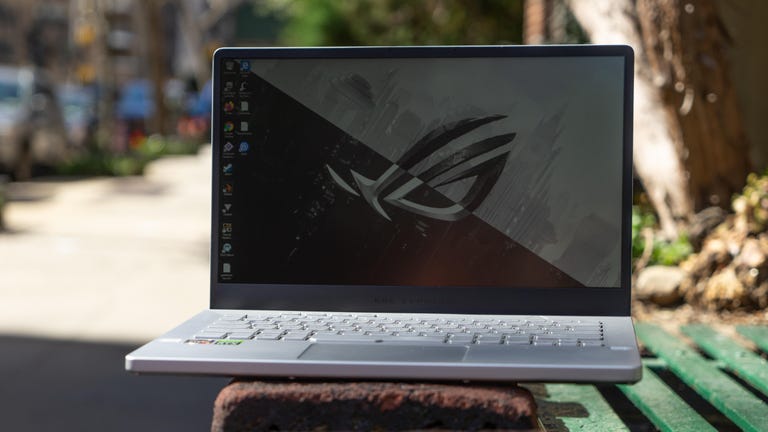 Why You Can Trust CNET
Why You Can Trust CNET Asus ROG Zephyrus G14 review: AMD makes this 14-inch gaming laptop fly
A fast 14-inch laptop that's not just for gaming.

The 14-inch Asus ROG Zephyrus G14 is one of the the thinnest, lightest gaming laptops we've tested. But it still manages to be one of the most powerful in its class, thanks to AMD's new eight-core (16 logical processor) Ryzen 9 4900HS processor. It also has an Nvidia RTX 2060 Max-Q graphics chip for gaming. That's a solid combo, but it does feel like the midlevel RTX 2060 isn't enough of a match for the high-end Ryzen 9. The base model starts at $1,050 (about £850 or AU$1,710) but my review model costs $1,450.
Like
- Excellent CPU performance for its size
- Comfortable keyboard with a surprising amount of travel
Don't like
- No webcam
- Power connector in the middle of the left side
- White keyboard backlight doesn't consistently shine through transparent keycap areas
- No Thunderbolt 3 connection
Taking a leaf out of Intel's Project Athena book, AMD recently introduced its HS Design Standard, though in AMD's case, the target is thin-and-light laptops with discrete graphics for gaming. That's in addition to offering good battery life for typical business use, in contrast to the more aggressively low-powered but business-focused Project Athena models. The G14 is the HSDS poster-child debut model, and it's an impressive one.
Asus ROG Zephyrus G14 (GA401IV-BR9N6)
| Price as reviewed | $1,450 |
|---|---|
| Display | 14-inch 1,920 x 1,080 120Hz |
| PC CPU | 3.0GHz AMD Ryzen 9 4900HS |
| PC Memory | 16GB 3,200MHz DDR4 |
| Graphics | Nvidia GeForce RTX 2060 Max-Q |
| Storage | 1TB SSD |
| Ports | 2 x USB-C (1 x PD and DisplayPort 1.4), 2 x USB-A, 1 x HDMI 2.0b, 1 x headset |
| Networking | Intel Wi-Fi 6 AX1200 (Gig+) , Bluetooth 5.0 |
| Operating system | Microsoft Windows Home (1909) |
| Weight | 3.5 pounds (1.6 kilograms) |
Why is it a big deal that this laptop has AMD's new Ryzen 9? The answer gets a little in the weeds, but read on for the details.
AMD's Renoir-generation Ryzen 4000-series CPUs -- beginning with this one -- are the company's first to work with Nvidia discrete graphics and support FreeSync on a built-in laptop display, thanks to a newer integrated graphics architecture. That's because Nvidia traditionally only supports adaptive refresh when display is on the GPU bus. The growth in USB-C/Thunderbolt monitors and high-refresh-rate laptop displays combined with the decreased willingness to pay the price and battery-life penalty for Nvidia's G-Sync hardware-based technology has required some rethinking of laptop graphics system design.
The test system I received didn't have a couple of the coolest new features of the G14 line, such as the 2,560x1,440 QHD screen or the optional AniMe Matrix lid with an LED array for displaying graphics and animations. The G14 comes in a handful of different configurations, all to be available between now and the end of May:
- GA401IH-BR7N2BL (gray), $1,050: FHD 60Hz, Ryzen 7 4800HS, 8GB RAM , 512GB SSD, GeForce GTX 1650
- GA401IU-BS76 (gray) $1,300: FHD 120Hz, Ryzen 7 4800HS, 16GB RAM, 512GB SSD, GeForce GTX 1660 Ti Max-Q
- GA401IV-BR9N6 (white), $1,450: FHD 120Hz, Ryzen 9 4900HS, 16GB RAM, 1TB SSD, GeForce RTX 2060 Max-Q
- GA401IV-PS96 (gray) or BS96-WH (white), $2,000: QHD 60Hz AniMe Matrix Display, Ryzen 9 4900HS, 16GB RAM, 1TB SSD, GeForce RTX 2060 Max-Q
Unless you're really budget strapped, I'd avoid the base model and go for the $1,300 one; 16GB RAM and the 1660 Ti are worth the extra $150. And if you do need to go cheap, opt for a far less expensive gaming laptop such as a Dell G3 15. You also have to ask yourself: Is 13.9 inches too small for me? It doesn't feel that much smaller than a 15.6, and works out to roughly an inch in both dimensions. It probably depends on the games you play, too.
Overall, I like the operational (if not aesthetic) design of the G14, with a few reservations. It feels solidly built and you can upgrade memory and SSD (by unscrewing the bottom panel). There's a bit more flex in the display than I like, but it doesn't seem fragile.
Somehow, despite its compact size, novel lid design and eye-catching ErgoLift hinge, which tilts the keyboard forward and allows for better airflow underneath, the G14 manages to look more gaming-functional than business-impressive. It has gamer-like angled vents, big keycaps and an irritating power connection placement -- in the middle of the left side, where the cord can block the HDMI and USB-C port -- perhaps.
But those chicklet keys feel good to type on for a laptop in this price range, offering a solid 1.7mm travel. I'd attach an external keyboard for gaming, though, because they're not quite as responsive as a lot of people might want. Asus doesn't cite an actuation pressure, but they feel stiff. The Precision touchpad works well, too. A stronger-than-usual stereo speaker system has front-driving tweeters and rear-driving woofers for a bassier sound than you typically hear from small laptops.
My don't-like list isn't empty, though. In order to see the keyboard backlighting consistently across the keys, you have to crank it all the way up. Even then it doesn't shine through some of the keys sufficiently. There's no keyboard combination for PgUp or PgDn. And there's no Thunderbolt 3 support -- that's on AMD, not Asus -- so you can't connect to a high-speed hub.
The chicklet keys have solid travel.
It also lacks a built-in webcam. Asus will sell you an optional external one, but that's not quite as good as a built-in one. As we've discovered lately, though it may not be something you use regularly, even crappy webcams can come in handy. The screen is Pantone Validated, but that just means it's better than it would have been had it not been factory calibrated. It's OK when you're not in a power-saving mode, but even the various gaming profiles Asus provides just do things like wash out the display (by boosting the brightness) in order to bring up detail in the shadows.
Go Speed Racer
Starting with its Zen architecture, AMD CPUs have routinely outperformed their Intel equivalents for multicore operations (like rendering video and generating thumbnails), so no surprise there. But with Renoir, AMD has boosted single-core speed to roughly match that of Intel's flagship ninth-gen mobile processor, the i9-9980HK, and not just in blow-out-the-windows Turbo mode. There doesn't seem to be a huge difference in performance between Performance and Turbo modes, though. It's less than 10% difference at most, and sometimes just a couple frames per second.
The GeForce RTX 2060 Max-Q GPU is serviceable enough to get an ass kicking at 120fps in Doom Eternal, but in most respects it's no better or worse than it is in other systems equipped with it. In cases where gaming workloads are balanced between the GPU and the CPU, however, rather than purely GPU-reliant -- Shadow of the Tomb Raider is a good example of a shared workload -- the Ryzen 9 seems to give the G14 an advantage.
AMD and Asus claim up to 10 hours of battery life. And yes, I hit 10.8 hours running streaming video tests. But that's in Silent Mode, which puts the discrete GPU to sleep, among other things. (The G14 can run off a 65-watt USB-C power adapter but enabling the discrete graphics requires the 180-watt AC adapter.) Working in Silent mode is another story. It dims the display too much and even when I bump the brightness up it's still lower contrast than in the higher-powered mode. In the default Performance mode, battery life still hit a decent 6 hours on that test. (Since the test results varied more widely than I like, I didn't report comparative results in a chart here.
In real-world use, though -- Silent mode with the brightness bumped up to a usable level, the Chrome and Firefox tabs I needed just to write this, Slack and streaming music for an hour or so -- the battery lasted only about 4.5 hours. It held out for 3.5 hours during the same session in Performance (that is, balanced) mode with an external powered display connected via USB-C DP. At least, that's my real world. Yours may vary.
The ROG Zephyrus G14 is an impressive little gaming laptop. Just be sure that "little" is what you really want and you don't mind switching to the less-impressive Silent mode for decent away-from-the-plug battery life.
Geekbench 5 (multi-core)
Cinebench R20 CPU (multi-core)
Cinebench R20 CPU (single core)
3DMark Fire Strike Ultra
3DMark Port Royal (RTX)
Shadow of the Tomb Raider gaming test
System configurations
| Apple MacBook Pro 16 | Apple macOS Catalina 10.15.1; 2.4GHz Intel Core i9-9980HK; 32GB DDR3 SDRAM 2,666MHz; 8GB Radeon Pro 5500M/1,536MB Intel HD Graphics 630; 2TB SSD |
|---|---|
| Dell XPS 15 (7950, OLED) | Microsoft WIndows 10 Home (1809); 2.4GHz Intel Core i7-99800HK; 32GB DDR4 SDRAM 2,667MHz, 4GB Nvidia GeForce GTX 1650, 1TB SSD |
| Maingear Element | Microsoft WIndows 10 Pro (1903); 2.6GHz Intel Core i7-9750H; 32GB DDR4 SDRAM 2,667MHz, 8GB Nvidia GeForce RTX 2070 with Max-Q Design, 2TB SSD |
| Razer Blade 15 Studio Editon | Microsoft Windows 10 Pro (1909); 2.6GHz Intel Core i7-9750H; 32GB DDR4 SDRAM 2,666MHz; 16GB Nvidia Quadro RTX 5000 with Max-Q Design; 1TB SSD |
| Razer Blade Advanced (2019, OLED) | Microsoft Windows 10 Home (64-bit); 2.6GHz Intel Core i7-9750H; 16GB DDR4 SDRAM 2,666MHz; 8GB Nvidia GeForce RTX 2080 with Max-Q Design; 512GB SSD |


